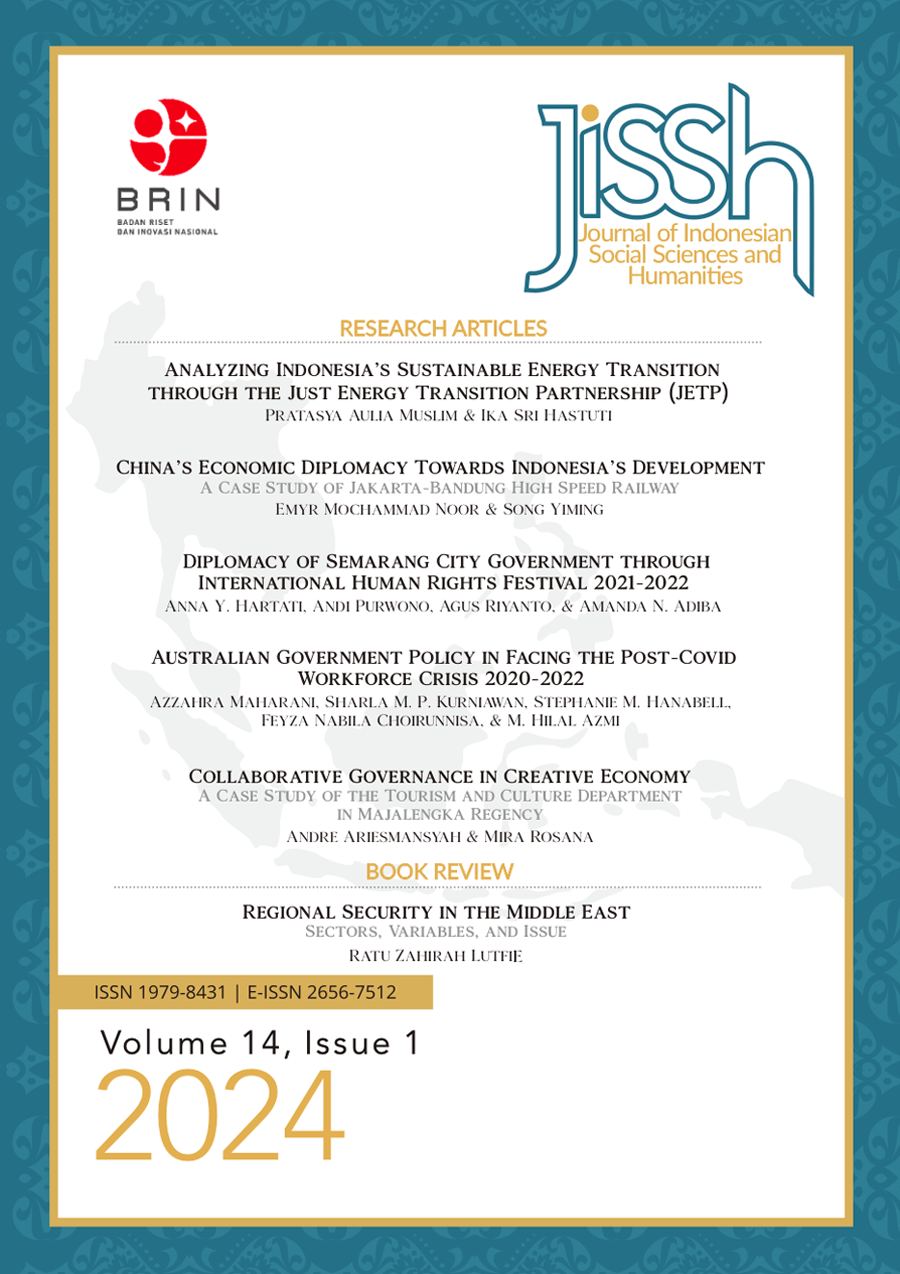Diplomacy of Semarang City Government through International Human Rights Festival 2021-2022
Keywords:
City Diplomacy, International Human Rights Festival, City Image, SemarangAbstract
Discourses on the role and responsibility of regional government in protecting and fulfilling human rights have drawn serious attention of international community. On the international level, the concept of human rights cities (Human Rights cities or regions) was introduced to promote more active engagement and empowerment in developing and advancing its respective regions. This discourse is facilitated by involvement and active participation of sub-national government (regional government or city government) in responding international issues. Studies on the involvement of cities in diplomacy has been conducted, yet none of those discussed the cities’ engagement in international human rights issues. Semarang city has been selected as the host of International Human Rights Festival in 2021. The purpose of this research is to find out the motivation of Semarang City Government in becoming the host of International Human Rights Festival. Theoretical framework for this research is city diplomacy and human cities rights concept. The method used in this research is qualitative, data collected through interview, observation and document study. The finding of this research shows that the purpose of Semarang city government in becoming the host of International Human Rights Festival in 2021 is to promote Semarang city’s image, advance international relations, to improve awarness of its people on human rights issues and promoting tourism.
References
Acuto, M., & Rayner, S. (2016). City networks: Breaking gridlock or forging (new) lock‐ins? International Affairs, 92(3), 723–741.
Alvarez, M., & Oddone, N. (2020). Revisiting paradiplomacy in the context of COVID-19. In R. Ventura De Marco (Ed.), Revisiting paradiplomacy in the context of COVID-19. E-International Relations.
Bigo, D. (2010). Freedom and speed in enlarged borderzones. In V. Squire (Ed.), The contested politics of mobility: Borderzones and irregularity (pp. 31–49). London: Routledge.
Duchacek, I. (1986). The territorial dimension of politics: Within, among and across nations. Westview Press.
Duchacek, I. D. (1988). Multicommunal and bicommunal polities and their international relations. In I. D. Duchacek, D. Latouche, & G. Stevenson (Eds.), Perforated sovereignties and international relations: Trans-sovereign contacts of subnational governments (pp. 3–28). Greenwood Press.
Duchacek, I. D. (1990). Perforated sovereignties: Towards a typology of new actors in international relations. In H. Michelmann & P. Soldatos (Eds.), Federalism and international relations: The role of subnational units (pp. 1–33). Clarendon Press.
Evans, P., Jacobson, H., & Putnam, R. (Eds.). (1993). Double-edged diplomacy: International bargaining and domestic politics. University of California Press.
Setzer, J., & Anderton, K. (2019). Subnational leaders and diplomacy. International Studies. https://doi.org/10.1093/acrefore/9780190846626.013.504
Soetjipto, W. A. (2015). HAM dan politik internasional: Sebuah pengantar [Human rights and international politics: An introduction]. Jakarta: Yayasan Pustaka Obor Indonesia.
Sujatmoko, A. (2016). Hukum HAM dan hukum humaniter [Human rights law and humanitarian law]. Jakarta: PT RajaGrafindo Persada.
Downloads
Published
Issue
Section
License
Copyright (c) 2024 Anna Yulia Hartati, Andi Purwono, Agus Riyanto, Amanda Noor Adiba

This work is licensed under a Creative Commons Attribution-ShareAlike 4.0 International License.
Authors who publish with this journal agree to the following terms:
1. Authors retain copyright and grant the journal right of first publication with the work simultaneously licensed under an Attribution-ShareAlike 4.0 International (CC BY-SA 4.0) license. This license allows others to remix, adapt, and build upon the work, as long as they credit the author and license their new creations under the same terms.
2. Authors may enter into separate, additional contractual arrangements for the non-exclusive distribution of the journal’s published version of the work (e.g., posting it to an institutional repository or including it in a book), provided there is an acknowledgment of its initial publication in this journal.
3. Authors are permitted and encouraged to post their work online (e.g., in institutional repositories or on their personal website) prior to and during the submission process, as this can lead to productive exchanges and increase citations of the published work (See The Effect of Open Access ).


















